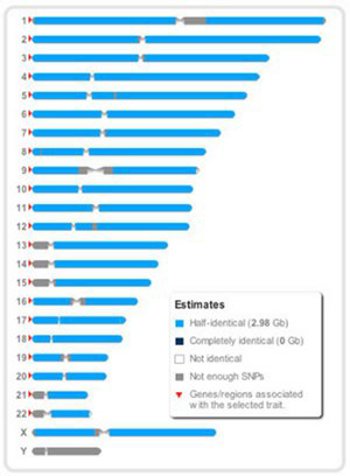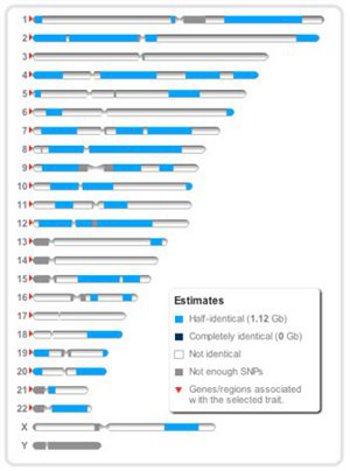
How can I confirm my child’s father is my husband, and not his brother?
January 12, 2016

- Related Topics:
- Paternity tests,
- Relatedness,
- Consumer genetic testing
A curious adult from Australia asks:
"We recently got paternity results back saying that a child was my husband’s daughter. But it turns out that unknown to us when we did the testing, my husband’s brother could also have been the father. The testing company says that we need to have his brother tested to confirm that my husband is indeed the father but his brother refuses to get tested. What are our options?"
The testing company is right. For reasons we talk about here, a standard paternity test will have trouble telling two potential fathers apart if they are brothers.
But these are not the only tests out there. A more powerful test like the one offered by 23andMe or AncestryDNA can easily tell if your husband is the father or the uncle of the child.
These can tell the difference because they look at a lot more DNA than does a standard paternity test (click here to learn more). And they are around the same price as the cheapest paternity tests.
They aren’t perfect though. Right now they will only test spit. So you can’t send in blood stains or any other tissue.
Also to my knowledge they can’t be used in a court of law. I don’t think there are any ways to get the results with a “chain of custody.” This is done to minimize the chances of cheating.
Still, in your case you will be able to tell if she is your husband’s daughter or niece. All it will take is a lot of spit from the both of them. No need to include his brother.
Test Results
This is what the result might look like from 23andMe if she were his daughter:

And here is what they would like if she is his niece:

A pretty big difference. With the daughter, everything is shaded in light blue but with the niece, only some of it is.
There is no uncertainty here. If the test comes back with only some light shaded blue, she is almost certainly not his daughter. She could be his niece, granddaughter, half-sister, or some other relationship where two people share around 25% of their DNA. (Click here for a rare exception where she could look like a niece but be a daughter.)
And if it is all shaded blue, she is his daughter.
Where All That Blue Comes From
If you know a bit about DNA, these results might be a bit confusing. We get half our DNA from our moms and half from our dads. So why does the daughter seemingly share 100% of her DNA with her dad?
She doesn’t. It kind of looks like that because of how the data is reported here.
Remember, we have two copies of each of our chromosomes. We get one from each pair from mom and one from dad.
You may notice, though, that this is only showing one from each pair (except for the X and the Y). So here if you match on both chromosomes, you get a darker blue. 23andMe calls this completely identical.
If you only match on one of the two, you are half identical. This is represented by the light blue.
So a daughter will be light blue all over because she got one whole chromosome from her dad. She is half identical over all of her chromosomes.
In any event, it will be relatively easy to tell whether she is a niece or a daughter with this kind of test.

Author: Dr. Barry Starr
Barry served as The Tech Geneticist from 2002-2018. He founded Ask-a-Geneticist, answered thousands of questions submitted by people from all around the world, and oversaw and edited all articles published during his tenure. AAG is part of the Stanford at The Tech program, which brings Stanford scientists to The Tech to answer questions for this site, as well as to run science activities with visitors at The Tech Interactive in downtown San Jose.
 Skip Navigation
Skip Navigation
